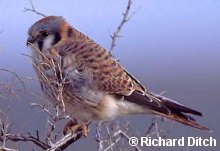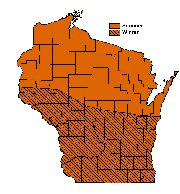American Kestrel (Falco sparverius)
Identification
Adult: Slightly smaller than the Merlin, sexes are similar in size. Males have more brilliant coloration patterns.ghtly smaller than the Merlin, sexes are similar in size. Males have more brilliant coloration patterns.
Tail: long, rust in color with a thick black terminal band and a thin white tip;
Throat: light throat patch;
Wings: long, angular with sharp point; underwings are pale. Males have grayish blue coverts compared to the rust/drab coloration of the females;
Breast & underside: Lightly barred, creamy to rust in color;
Head: orange/rust with dark spot on top, double black stripes on the face, one resembles a mustache;
Eye: dark brown with yellowish eye ring.
Immature: Similar to adult male, but the backside is completely barred.
Underside: buff in color with heavy streaking;
Eye: dark brown with yellowish eye ring.
Habitat
Prefers open areas like grasslands, wood lots, and agricultural land. Commonly observed perching on electrical wires.
Nests: in cavities; adapts very well to artificial nests.
Range
Common summer resident statewide; present in southern 1/2 of the state during winter.
Call
 Audio recordings donated by John Feith.
Additional bird call recordings available at www.caculo.com/birdsongs
Audio recordings donated by John Feith.
Additional bird call recordings available at www.caculo.com/birdsongs

